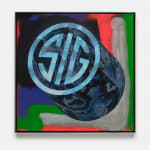
Awol Erizku Ethiopian-American, b. 1988
SIG SAUER (TESTED FOR EVERYTHING, GUARANTEED FOR ANYTHING), 2024
UV Inkjet, spray paint and acrylic on canvas
45.7 x 45.7 cm. (18 x 18 in.)
Copyright The Artist
Further images
In this series of ten paintings, Awol Erizku overlays the logos of global firearm manufacturers with gestural, graffiti-like interventions. Logos from companies such as Savage Arms, Smith & Wesson, Browning,...
In this series of ten paintings, Awol Erizku overlays the logos of global firearm manufacturers with gestural, graffiti-like interventions. Logos from companies such as Savage Arms, Smith & Wesson, Browning, SIG Sauer, Benelli, and Taurus are partially obscured or disrupted by vivid marks – sprayed, brushed, or scrawled across the surface. These expressive gestures clash with the clean, mechanical precision of the logos, setting up a visual tension between corporate control and individual creativity and resistance.
Erizku treats the firearm logos as loaded cultural symbols – emblems of state power, racialised violence, and commercial spectacle. By inserting them into the visual language of street art, he situates these brands within a context of urban resistance and coded protest. The graffiti-style markings, often associated with marginalised voices and counterculture, undermine the authority of the logos, refusing the neutrality that branding attempts to project.
The juxtaposition reveals the ways in which firearm companies aestheticise violence through design and repetition. Erizku exposes the seduction of these symbols – their familiarity, their presence in everyday culture – and reframes them as icons of systemic aggression. He thus critiques the commodification of violence and interrogates the complicity of branding in shaping social attitudes.
Erizku treats the firearm logos as loaded cultural symbols – emblems of state power, racialised violence, and commercial spectacle. By inserting them into the visual language of street art, he situates these brands within a context of urban resistance and coded protest. The graffiti-style markings, often associated with marginalised voices and counterculture, undermine the authority of the logos, refusing the neutrality that branding attempts to project.
The juxtaposition reveals the ways in which firearm companies aestheticise violence through design and repetition. Erizku exposes the seduction of these symbols – their familiarity, their presence in everyday culture – and reframes them as icons of systemic aggression. He thus critiques the commodification of violence and interrogates the complicity of branding in shaping social attitudes.
